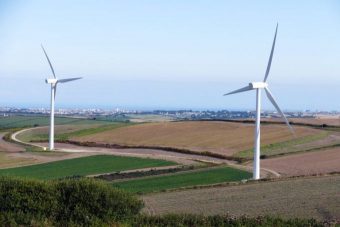
Several windfarm operators in South Australia have already revised their settings to allow them to ride through larger network disruptions, following the storm in September that caused a statewide blackout, according to an update by the Australian Energy Market Operator (Aemo).
New information released by Aemo on Wednesday morning reveals nine of 13 windfarms in the state “tripped” after freak winds blew over several major transmission lines in the state.
The loss of the power lines caused six “voltage disturbances” in the network. Generators, including windfarms, have safety settings which automatically disconnect from the grid when there are more than a set number of such disturbances.
It appeared almost a third of the state’s windfarms had settings that allowed them to ride through the six disturbances, as did all the state’s thermal generators.
Aemo said it was working with both windfarm operators and turbine manufacturers to better understand these “voltage ride-through” settings.
“Several windfarms have already implemented revised settings, allowing them to ride through a higher number of disturbances,” Aemo said in a statement.
When the nine windfarms disconnected, they removed 445 MW of generation from the network, causing a surge of power to be drawn from the Heywood interconnector with Victoria. That caused another automatic safety trip, shutting down the interconnector. In turn, that caused trips at the state’s thermal generators, resulting in the statewide blackout.
The new information was sure to reignite a campaign being launched against renewable energy.
Energy expert Dylan McConnell, from the Melbourne Energy Institute, told Guardian Australia it was likely windfarms needed more conservative “voltage ride-through” settings than coal or gas generators.
But he said the fact that a number of windfarms did ride through the event suggested their disconnection from the grid in South Australia was not a fundamental issue with wind power, but rather an issue with the choice of settings.
However, McConnell said the voltage disruptions were very severe, and potentially big enough to cause damage to generators that remained connected.
The report noted that voltage levels were usually required to be maintained within 10% of a line’s rating. “If voltage levels are not maintained within this range, damage can occur to the network or customer-connected equipment, and power system protection equipment might not operate correctly,” it said.
But three of the disruptions ahead of the blackout involved voltage dropping to 60% below the line’s rating.
McConnell said: “There are obviously questions about whether the preset limit (for voltage ride-through) was too conservative. But there is also a question of whether it [is] reasonable to think that a generator should ride a voltage collapse all the way down.”
McConnell also pointed out that if South Australia had fewer windfarms, this particular event was likely to have played out exactly the same way.
The large number of windfarms in the state was a factor in the shutting of the Northern coal-fired power generator in Port Augusta. If that generator was still running, it would have been cut off from the grid by the downed power lines, creating a similar disruption to the tripped windfarms.
“Yes, if there was gas generator or coal generator in Adelaide, then yes it might have ridden through the fault. But if you’re comparing the current situation to one where there was a coal generator in Port Augusta, you would have had a significant loss of generation,” he said.
McConnell said although the storm was a freak event, the resulting analysis could help network operators, market operators and policymakers create a more robust network.
“There’s a question about having a diversity of renewable energy resources,” he said.
Aemo was continuing to investigate the event.
Source: theguardian.com



